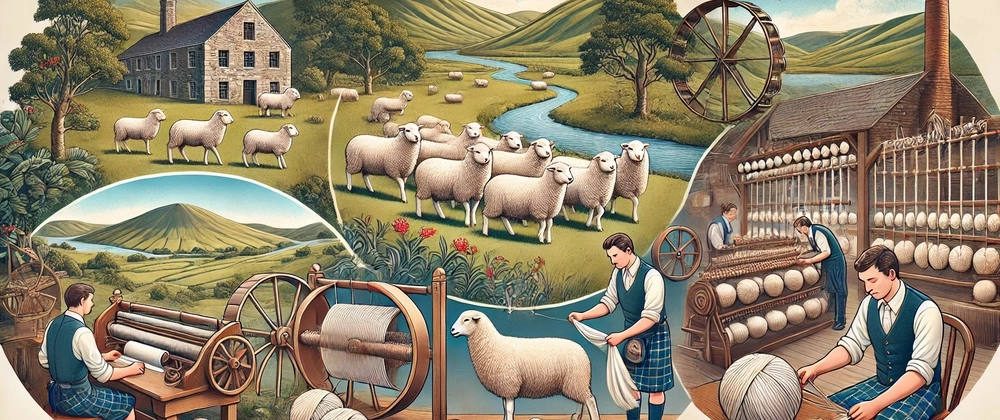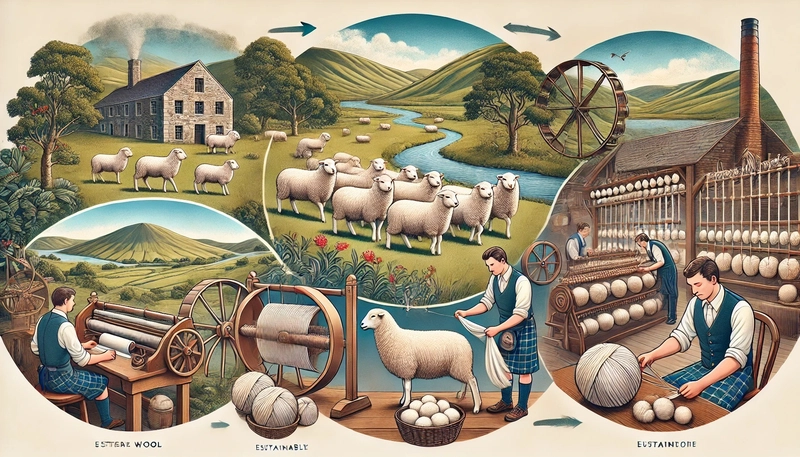Introduction: The Journey of Wool from Farm to Fashion
Kilts are one of the most iconic garments in the world, deeply rooted in Scottish tradition and craftsmanship. While the tartan patterns and pleating are essential elements, the foundation of a high-quality kilt is the wool. But where does this wool come from, and how is it produced ethically?
As consumers become more conscious of sustainable and ethical fashion, the demand for responsibly sourced wool has grown. Ethical wool production prioritizes animal welfare, environmental sustainability, and fair labor practices, ensuring that each step of the process respects both nature and the artisans who create the final product.
Let’s explore the journey of wool from sheep to kilt, breaking down the key stages of ethical wool production.
1. Ethical Sheep Farming: The First Step
1.1 The Importance of Responsible Sheep Farming
The journey of a kilt begins with the sheep. Ethical wool production starts with sheep that are raised in humane conditions, with a focus on:
✔ Animal welfare – No unnecessary harm or stress to the sheep.
✔ Sustainable grazing – Maintaining healthy pastures and reducing land degradation.
✔ Natural diets – Ensuring sheep eat nutrient-rich, chemical-free grass.
Sheep breeds commonly used for kilt wool include:
✔ Scottish Blackface – A hardy breed known for thick, coarse wool, ideal for kilts.
✔ Merino Sheep – Known for their soft, fine wool used in premium garments.
✔ Cheviot Sheep – Produces durable, elastic wool perfect for weaving.
1.2 Ethical Shearing Practices
Shearing is a necessary and humane process when done correctly. Ethical wool farms prioritize:
✔ Pain-free shearing techniques – Avoiding cuts or injuries.
✔ Certified shearers trained in animal welfare.
✔ Seasonal shearing schedules – Ensuring sheep are sheared at the right time for their health and comfort.
Avoiding Mulesing:
Some wool producers use mulesing, a painful process to prevent flystrike in sheep. Ethical wool farms ensure mulesing-free wool, prioritizing alternative fly control methods.
2. Cleaning and Processing Wool: The Sustainable Way
2.1 Gentle Wool Cleaning (Scouring)
Once the wool is sheared, it goes through a scouring process to remove dirt, lanolin (natural oil), and plant debris. Ethical wool production uses:
✔ Biodegradable soaps instead of harsh chemicals.
✔ Water recycling systems to reduce waste.
✔ Energy-efficient processing methods to limit carbon emissions.
2.2 Carding and Spinning the Wool
The cleaned wool is then carded, a process that aligns the fibers into smooth strands. It is then spun into yarn, either by traditional hand-spinning or with low-impact machines.
✔ Hand-spun wool is valued for its artisanal quality.
✔ Sustainably powered spinning mills use renewable energy sources.
3. Weaving Ethical Tartan: Tradition Meets Sustainability
3.1 The Role of Ethical Mills
The wool yarn is then sent to tartan weaving mills, where it is transformed into the fabric that will eventually become a kilt. Ethical mills focus on:
✔ Traditional craftsmanship – Keeping ancient weaving techniques alive.
✔ Eco-friendly dyes – Using plant-based or low-impact synthetic dyes.
✔ Waste reduction – Recycling excess yarn and fabric scraps.
Notable ethical wool mills include:
✔ Harris Tweed Mills (Scotland) – Known for sustainable, handwoven wool.
✔ Lochcarron of Scotland – A historic tartan weaving mill with sustainability initiatives.
✔ Prickly Thistle (Highlands) – A modern mill focusing on slow fashion and ethical wool.
3.2 Handwoven vs. Machine-Woven Tartan
✔ Handwoven tartan – Requires more time but is crafted with extreme precision and care.
✔ Machine-woven tartan – More accessible but can still be made ethically when sourced responsibly.
4. Tailoring the Kilt: Handcrafted with Care
4.1 Sustainable Kilt-Making Practices
Once the tartan fabric is ready, expert kiltmakers begin the tailoring process. Ethical kiltmakers focus on:
✔ Hand-cutting and sewing – Reducing fabric waste.
✔ Local artisanship – Supporting skilled workers instead of mass production.
✔ Durability over fast fashion – Kilts are designed to last a lifetime, reducing waste.
4.2 The Role of Upcycling and Repair
An ethical approach to kilt production also involves:
✔ Upcycling wool scraps into accessories like scarves and hats.
✔ Kilt repair services to extend the garment’s lifespan.
✔ Second-hand and vintage kilts gaining popularity as a sustainable alternative.
5. Ethical Certifications and Transparency
For consumers looking to buy ethically produced kilts, certain certifications ensure high standards in animal welfare, environmental impact, and fair labor.
5.1 Key Wool Certifications
✔ Responsible Wool Standard (RWS) – Ensures humane treatment of sheep and sustainable land use.
✔ Global Organic Textile Standard (GOTS) – Certifies organic wool and eco-friendly processing.
✔ Cradle to Cradle Certification – Focuses on circular fashion with recyclable textiles.
5.2 Supporting Transparent Brands
Consumers should look for brands that disclose their supply chains, including:
✔ Where the wool is sourced.
✔ How the wool is processed and dyed.
✔ Who weaves and tailors the final kilt.
Companies that prioritize full traceability are leading the way in ethical wool production.
6. The Future of Ethical Wool Kilts
As sustainable fashion gains momentum, the future of ethical kilt production looks promising. Emerging trends include:
✔ Regenerative farming practices – Improving soil health and biodiversity.
✔ Carbon-neutral tartan weaving – Mills adopting solar and wind energy.
✔ Vegan alternatives – Some brands experimenting with plant-based or recycled wool-like fabrics.
Ethical wool production is not just about producing sustainable garments—it’s about preserving traditions, protecting animals, and ensuring fair wages for artisans.
Conclusion: Choosing Ethical Kilts for a Sustainable Future
From responsible sheep farming to artisanal kilt-making, the journey from sheep to kilt is undergoing a sustainable transformation. Ethical wool production ensures that quality, heritage, and environmental consciousness go hand in hand.
By choosing kilts made from ethically sourced wool, consumers can support sustainability, animal welfare, and skilled craftsmanship, while still wearing a timeless piece of history.
Would you invest in an ethically made kilt? Let’s discuss the future of sustainable wool fashion.






Top comments (0)